
This is a fun outoor lab for students' to understand the nature surrounding them.
- Subject:
- Environmental Science
- Physical Science
- Material Type:
- Activity/Lab
- Homework/Assignment
- Student Guide
- Author:
- Kathryn Busch
- Date Added:
- 10/08/2023

This is a fun outoor lab for students' to understand the nature surrounding them.
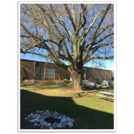
Esta es una lección para el aprendizaje a distancia que los alumnos pueden completar en casa.Los estudiantes explorarán al aire libre para ver ejemplos de organismos que tienen sus necesidades cubiertas.Esta actividad fue creada por Out Teach (out-teach.org), una organización sin fines de lucro que proporciona aprendizaje experiencial al aire libre, con el objetivo de transformar la educación de las ciencias para los estudiantes en comunidades más desatendidas.

Corresponds with Chapter 5 Openstax Biology 2e "Structure and Function of Plasma Membrane"
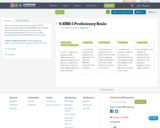
This is a task neutral proficiency scale for 5-ESS1-1. Resources used to make this: NGSS.NSTA.org, Appendix E from the NextGenScience site and the actual performance expectations. This scale was created through collaboration with five elementary teachers.
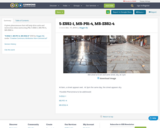
A given phenomenon that will help drive units and instruction when instructing PEs: 5-ESS2-1, MS-PS1-4, MS-ESS2-4
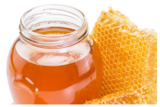
Learn how honey is made and used. This lesson includes learning objectives, material and resource lists, background information, activities, reading selections, writing assignments, a game, assessments, and support documents. See the Educator's Guide for more video links and recommended readings.
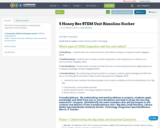
This Unit is Transdisciplinary reinforcing the importance of the honeybee.
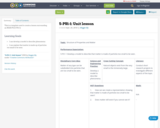
This is a template used to create a lesson surrounding an NGSS PE (5-PS1-1)
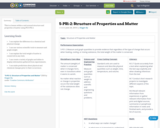
This is a lesson within a unit around structure and properties of matter using PE 5-PS1-2.
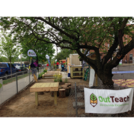
Students may recognize the importance of their senses, but they don't often focus on them individually. Students will experiment with sounds made by leaves, feeling different textures, observing different colors, and much more.
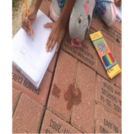
Esta es una lección para el aprendizaje a distancia que los alumnos pueden completar en casa.Los estudiantes explorarán al aire libre en busca de ejemplos de transferencia de calor a través de la conducción, la convección y la radiación.Esta actividad fue creada por Out Teach (out-teach.org), una organización sin fines de lucro que proporciona aprendizaje experiencial al aire libre, con el objetivo de transformar la educación de las ciencias para los estudiantes en comunidades más desatendidas.
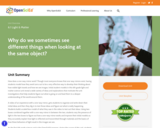
How does a one-way mirror work? Though most everyone knows that one-way mirrors exist, having students model how they work turns out to be a very effective way to develop their thinking about how visible light travels and how we see images. Initial student models reveal a wide variety of ideas and explanations that motivate the unit investigations that help students figure out what is going on and lead them to a deeper understanding of the world around them.
As the first unit in the OpenSciEd program, during the course of this unit, students also develop the foundation for classroom norms for collaboration that will be important across the whole program.
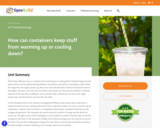
This unit on thermal energy transfer begins with students testing whether a new plastic cup sold by a store keeps a drink colder for longer than the regular plastic cup that comes free with the drink.
Through a series of lab investigations and simulations, students find two ways to transfer energy into the drink: (1) the absorption of light and (2) thermal energy from the warmer air around the drink. They are then challenged to design their own drink container that can perform as well as the store-bought container, following a set of design criteria and constraints.
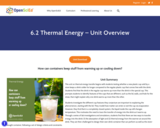
Unit Summary
This unit on thermal energy transfer begins with students testing whether a new plastic cup sold by a store keeps a drink colder for longer compared to the regular plastic cup that comes free with the drink. Students find that the drink in the regular cup warms up more than the drink in the special cup. This prompts students to identify features of the cups that are different, such as the lid, walls, and hole for the straw, that might explain why one drink warms up more than the other.
Students investigate the different cup features they conjecture are important to explaining the phenomenon, starting with the lid. They model how matter can enter or exit the cup via evaporation However, they find that in a completely closed system, the liquid inside the cup still changes temperature. This motivates the need to trace the transfer of energy into the drink as it warms up. Through a series of lab investigations and simulations, students find that there are two ways to transfer energy into the drink: (1) the absorption of light and (2) thermal energy from the warmer air around the drink. They are then challenged to design their own drink container that can perform as well as the store-bought container, following a set of design criteria and constraints.
This unit builds toward the following NGSS Performance Expectations (PEs) as described in the OpenSciEd Scope & Sequence: MS-PS1-4*, MS-PS3-3, MS-PS3-4, MS-PS3-5, MS-PS4-2*, MS-ETS1-4. The OpenSciEd units are designed for hands-on learning and therefore materials are necessary to teach the unit. These materials can be purchased as science kits or assembled using the kit material list.
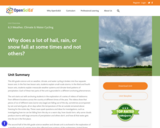
The goals of OpenSciEd are to ensure any science teacher, anywhere, can access and download freely available, high quality, locally adaptable full-course materials. REMOTE LEARNING GUIDE FOR THIS UNIT NOW AVAILABLE!
This unit on weather, climate, and water cycling is broken into four separate lesson sets. In the first two lesson sets, students explain small-scale storms. In the third and fourth lesson sets, students explain mesoscale weather systems and climate-level patterns of precipitation. Each of these two parts of the unit is grounded in a different anchoring phenomenon.
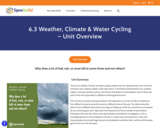
This unit on weather, climate, and water cycling is broken into four separate lesson sets. In the first two lesson sets, students explain small-scale storms. In the third and fourth lesson sets, students explain mesoscale weather systems and climate-level patterns of precipitation. Each of these two parts of the unit is grounded in a different anchoring phenomenon.
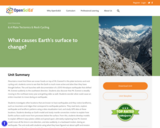
In this plate tectonics and rock cycling unit, students come to see that the Earth is much more active and alive than they have thought before. The unit launches with documentation of a 2015 Himalayan earthquake that shifted Mt. Everest suddenly to the southwest direction. Students read texts, explore earthquake and landform patterns using a data visualization tool, and study GPS data.
This unit is part of the OpenSciEd core instructional materials for middle school.

This unit begins with students experiencing, through text and video, a devastating natural event that caused major flooding in coastal towns of Japan. Through this anchoring phenomenon, students think about ways to detect tsunamis, warn people, and reduce damage from the wave. As students design solutions to solve this problem, they begin to wonder about the natural hazard itself: what causes it, where it happens, and how it causes damage.
This unit is part of the OpenSciEd core instructional materials for middle school.
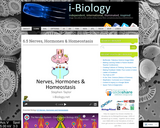
6.5 Nerves, Hormones & Homeostasis | i-Biologyi-biology.net/ibdpbio/06-human-health.../nerves-hormones-homeostasis/Cached
SimilarEssential Biology 6.5 Nerves, Hormones and Homeostasis .........o0O0o. ... Tutorial and game from think-bank ..... Online Learning ... Creative Commons License
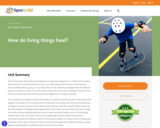
This unit launches with students hearing about an injury that happened to a middle school student that caused him to need stitches, pins, and a cast. They analyze doctor reports and develop an initial model for what is going on in our body when it heals. Students investigate what the different parts of our body are made of, from the macro scale to the micro scale. They figure out parts of our body are made of cells and that these cells work together for our body to function.
This unit is part of the OpenSciEd core instructional materials for middle school.